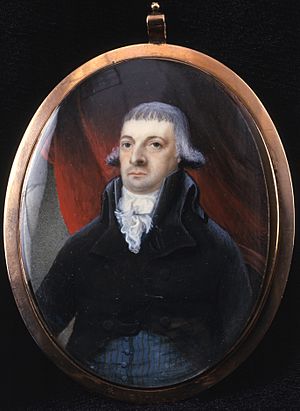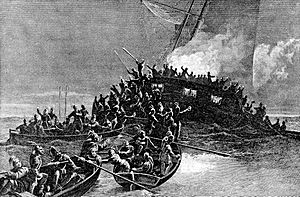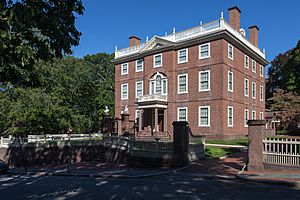John Brown I facts for kids
Quick facts for kids
John Brown I
|
|
|---|---|

Miniature of John Brown by Edward Malbone
|
|
| Member of the U.S. House of Representatives from Rhode Island's at-large congressional district | |
| In office 1799–1801 |
|
| Preceded by | Thomas Tillinghast |
| Succeeded by | Joseph Stanton, Jr. |
| Personal details | |
| Born | January 27, 1736 Providence, Rhode Island Colony, British America |
| Died | September 20, 1803 (aged 67) Providence, Rhode Island, U.S. |
| Nationality | American |
| Spouse | Sarah Smith |
| Children | James Brown III Abigail Brown Francis Sarah Brown Herreshoff Alice Brown Mason |
| Parents | James Brown II Hope Power |
| Relatives | Chad Brown, ancestor Nicholas Brown, brother Moses Brown, brother Joseph Brown, brother John Brown Francis, grandson |
| Occupation | Merchant Slave trader Statesman |
John Brown I (January 27, 1736 – September 20, 1803) was an important American merchant and politician from Providence, Rhode Island. He was also involved in the slave trade.
John Brown and his brothers, Nicholas, Joseph, and Moses, helped create Brown University. It was first called the College of Rhode Island. They moved the college to their family's land in Providence.
In 1770, John Brown helped start the building of the university's oldest structure. He was also the university's treasurer for 21 years. This was from 1775 to 1796. Brown also helped start Providence Bank in 1791. He became its first president.
He played a big part in the American Revolution. He helped cause the 1772 Gaspee Affair. He also served in both state and national government. At the same time, he strongly supported slavery. He often argued with his brother Moses, who wanted to end slavery.
Today, John Brown's home in Providence is a museum. It is also a National Historic Landmark.
Contents
John Brown's Early Life
John Brown was born in Providence on January 27, 1736. His parents were James Brown II and Hope Power. His father was a merchant. He traded in slaves, rum, and other goods.
John had five siblings. They were Mary, James III, Nicholas, Joseph, and Moses. His family was important in Providence.
His Family Connections
John Brown was a descendant of Chad Brown. Chad Brown helped found Providence. He was also an early Baptist minister.
John's uncle, Obadiah Brown I, worked with John's father in trade. This included trading in enslaved people. After John's father died, Obadiah helped raise the children. He later formed a business with John and his brothers.
John's nephew, Nicholas Brown Jr., later became a philanthropist. Brown University is named after him.
John Brown's Career and Businesses
Brown owned a successful business with his brothers. They worked in farming and shipping. He was involved in the slave trade and the China trade. He also invested in privateers. These were private ships used in wartime.
Role in the American Revolution
Brown was a leader in the Sons of Liberty. He helped cause the burning of the Gaspee in 1772. This event was a major act of defiance against British rule. It helped lead to the American Revolution.
In 1775, John Brown sold the United States Navy its first ship. It was called the USS Providence. Brown was chosen as a delegate for Rhode Island to the Continental Congress in 1784–1785. However, he did not attend.
Building the USS Providence
The Providence was the first warship for America's Continental Navy. John Brown built it in 1768. Rhode Island bought it to protect its shipping from British attacks. The ship later fought in 60 battles. It captured 40 British ships. It was commanded for a time by John Paul Jones. He is known as the father of the American Navy.
His Business Ventures
Brown's business interests were varied. Besides the slave trade, he built ships and bought and sold land. He was also a partner in the Hope Furnace. This furnace made cannons during the American Revolution.
In 1791, Brown started Providence Bank. This was the first bank in Rhode Island. The original Providence Bank building still stands in Providence. It is now the office of the Brown & Ives Land Company. This company also has roots in John Brown's businesses.
Political Activity and Later Life

John Brown was elected to the United States House of Representatives in 1798. He served one two-year term. The carriage he used to travel to Washington is still kept at the John Brown House in Providence.
Brown was a strong supporter of the Federalist Party. He worked to make sure Rhode Island joined the federal union.
Death and Burial
John Brown died in Providence on September 20, 1803. He was buried in the Brown family plot. This is in the North Burial Ground in Providence.
John Brown's Personal Life
John Brown was married to Sarah (Smith) Brown. They had four children:
- James Brown III (1761–1834)
- Abigail Brown Francis
- Sarah Brown Herreshoff (1773–1846)
- Alice Brown Mason
Notable Descendants
John Brown's grandson, John Brown Francis, later became a U.S. Senator and Governor of Rhode Island.
His grandsons also founded the Herreshoff Manufacturing Company. This company built boats in Bristol, Rhode Island.
See also
- John Brown House
- Elkanah Watson


